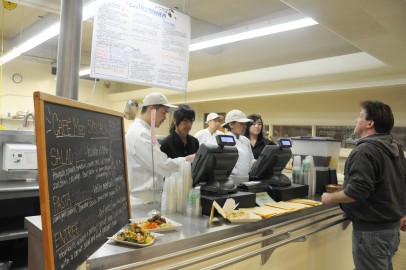Culinary program avoids getting chopped

Last semester the Culinary Department of City College was threatened with closure if it didn’t cut $250,000 from its budget.
The department not only survived the financial reduction, but opened its doors on Aug. 25 with a new cuisine in their Quick Service Restaurant, Café Med, which replaced the former Latin Quarter.
Third semester culinary student, Kara McCann, gave her perspective on the seemingly resolved issue.
“They told us it may close down, but they were just rumors,” McCann said, “I didn’t think it was actually going to close.”
On Apr. 27, The SF Chronicle reported that the program generates $900,000, but costs City College $1.6 million to run.
Every day, more than 900 students dine at the cafeteria Culinary Arts and Department Chair Tannis Reinhertz told The Guardsman last semester.
Culinary students were informed in late June that the restaurant would change its theme, which is later than usual according to McCann. This didn’t leave much preparation time for a menu with such diverse cultural food.
According to the City College website, the restaurant will offer “a variety of dishes ranging from Italian and Spanish to Grecian and Turkish and more.” It also has a new look, with high top tables and seating.
Collectively, the Culinary Program at City College consists of over 70 chefs and offers five credits for each class. The restaurant reinvents itself often in order to expose students to different cultural and ethnic food, according to the City college website, and the restaurant is entirely student-run.
Vincent Paratore, who has been teaching at City College for four years, has high expectations for the students in this course.
“We change themes every semester. It’s an incredible learning experience. I want them to know the business aspect. If you want to make it in San Francisco, you have to be creative,” Paratore said.
Mediterranean food comes from 21 countries surrounding the Mediterranean Sea, and consists of primarily fruits, vegetables, poultry and seafood. With over ten different meals to choose from, which is more than was offered in the past, student’s tasks are more challenging.
“I want them eating and thinking about the food, and students will rotate duties in the kitchen, so everyone knows how to do each job,” Paratore said. “They will be doing work in a realistic restaurant environment.”
The students even present themselves as professionals—cooks wear formal white cooking uniforms and the student cashiers wear fancy, all black attire.
The Mediterranean flavor is a new experience for third year culinary student Allan Pasley, a cook at Café Med who is also taking advanced baking.
“It’s different. In other courses I was cooking larger quantities of food—here we’re making individual dishes at the very moment it’s ordered,” Pasley said.
Café Med offers weekly specials, created by the students, which so far have been less than $7.00 each and contain less than 700 calories.
“The most popular so far is the Gyro, a dish (introduced to the United States in 1965) with a Pita bread wrap containing your choice of lamb or chicken, with lettuce, onion and cucumber sauce,” Pasley said.
They don’t offer desserts yet, although students do have the freedom to put them on the menu.
